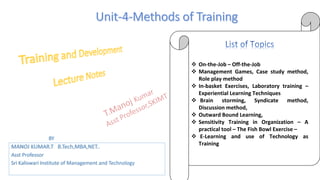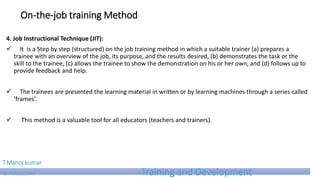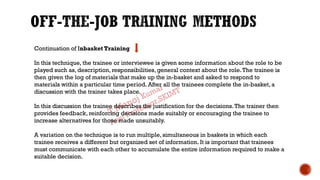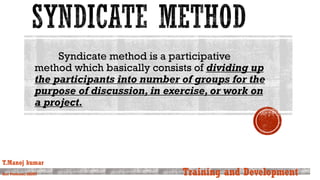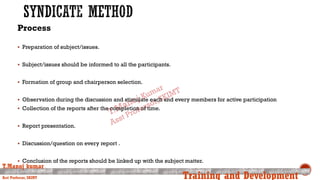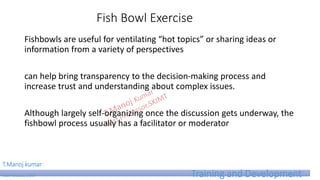Unit 4-methods of training pptx
- 2. On-the-Job – Off-the-Job Management Games, Case study method, Role play method In-basket Exercises, Laboratory training – Experiential Learning Techniques Brain storming, Syndicate method, Discussion method, Outward Bound Learning, Sensitivity Training in Organization – A practical tool – The Fish Bowl Exercise – E-Learning and use of Technology as Training BY MANOJ KUMAR.T B.Tech,MBA,NET.. Asst Professor Sri Kaliswari Institute of Management and Technology
- 3. UNIT-4 TRAINING METHODS ON THE JOB TRAINING OFF THE JOB TRAINING
- 4. T.Manoj kumar Asst Professor, SKIMT Training and Development
- 5. On-the-job training Method Under these methods new or inexperienced employees learn through observing peers or managers performing the job and trying to imitate their behaviour. These methods do not cost much and are less disruptive as employees are always on the job Training is given on the same machines and experience would be on already approved standards, and above all the trainee is learning while earning T.Manoj kumar Asst Professor, SKIMT Training and Development
- 6. On-the-job training Method 1 Coaching 2. Mentoring 3. Job Rotation 4. Job Instruction Technology 5. Apprenticeship 6. Understudy T.Manoj kumar Asst Professor, SKIMT Training and Development
- 7. On-the-job training Method 1. Coaching: Coaching is a one-to-one training. It helps in quickly identifying the weak areas and tries to focus on them. It also offers the benefit of transferring theory learning to practice. The biggest problem is that it perpetrates the existing practices and styles. 2.Mentoring The focus in this training is on the development of attitude. It is used for managerial employees. Mentoring is always done by a senior inside person. It is also one-to- one interaction, like coaching. T.Manoj kumar Asst Professor, SKIMT Training and Development
- 8. On-the-job training Method 3. Job Rotation: It is the process of training employees by rotating them through a series of related jobs. Rotation not only makes a person well acquainted with different jobs, but it also alleviates boredom and allows to develop rapport with a number of people. Rotation must be logical. T.Manoj kumar Asst Professor, SKIMT Training and Development
- 9. On-the-job training Method 4. Job Instructional Technique (JIT): It is a Step by step (structured) on the job training method in which a suitable trainer (a) prepares a trainee with an overview of the job, its purpose, and the results desired, (b) demonstrates the task or the skill to the trainee, (c) allows the trainee to show the demonstration on his or her own, and (d) follows up to provide feedback and help. The trainees are presented the learning material in written or by learning machines through a series called ‘frames’. This method is a valuable tool for all educators (teachers and trainers). T.Manoj kumar Asst Professor, SKIMT Training and Development
- 10. On-the-job training Method 5. Apprenticeship: Apprenticeship is a system of training a new generation of practitioners of a skill . This method of training is in vogue in those trades, crafts and technical fields in which a long period is required for gaining proficiency. The trainees serve as apprentices to experts for long periods. They have to work in direct association with and also under the direct supervision of their masters. T.Manoj kumar Asst Professor, SKIMT Training and Development
- 11. On-the-job training Method 6. Understudy: In this method, a superior gives training to a subordinate as his understudy like an assistant to a manager or director (in a film). The subordinate learns through experience and observation by participating in handling day to day problems. Basic purpose is to prepare subordinate for assuming the full responsibilities and duties. T.Manoj kumar Asst Professor, SKIMT Training and Development
- 12. Off-the-job Training Methods Off-the-job training methods are conducted in separate from the job environment, study material is supplied, there is full concentration on learning rather than performing, and there is freedom of expression. Important methods include: T.Manoj kumar Asst Professor, SKIMT Training and Development
- 13. Off-the-job Training Methods 1. Lectures and Conferences: Lectures and conferences are the traditional and direct method of instruction. Every training programme starts with lecture and conference. It’s a verbal presentation for a large audience. However, the lectures have to be motivating and creating interest among trainees. The speaker must have considerable depth in the subject. In the colleges and universities, lectures and seminars are the most common methods used for training T.Manoj kumar Asst Professor, SKIMT Training and Development
- 14. Off-the-job Training Methods 2. Vestibule Training: Vestibule Training is a term for near-the-job training, as it offers access to something new (learning). In vestibule training, the workers are trained in a prototype environment on specific jobs in a special part of the plant. An attempt is made to create working condition similar to the actual workshop conditions. After training workers in such condition, the trained workers may be put on similar jobs in the actual workshop. This enables the workers to secure training in the best methods to work and to get rid of initial nervousness. During the Second World War II, this method was used to train a large number of workers in a short period of time. It may also be used as a preliminary to on-the job training T.Manoj kumar Asst Professor, SKIMT Training and Development
- 15. Off-the-job Training Methods 3. Simulation Exercise Simulation is any artificial environment exactly similar to the actual situation. There are four basic simulation techniques used for imparting training: management games, case study, role playing, and in-basket training. T.Manoj kumar Asst Professor, SKIMT Training and Development
- 17. 3. (a) Management Games: Properly designed games help to ingrain thinking habits, analytical, logical and reasoning capabilities, importance of team work, time management, to make decisions lacking complete information, communication and leadership capabilities. Use of management games can encourage novel, innovative mechanisms for coping with stress. Management games orient a candidate with practical applicability of the subject.These games help to appreciate management concepts in a practical way T.Manoj kumar Asst Professor, SKIMT Training and Development
- 18. 3.(b) Case Study: Case studies are complex examples which give an insight into the context of a problem as well as illustrating the main point. Case Studies are trainee centered activities based on topics that demonstrate theoretical concepts in an applied setting. A case study allows the application of theoretical concepts to be demonstrated, thus bridging the gap between theory and practice, encourage active learning, provides an opportunity for the development of key skills such as communication, group working and problem solving, and increases the trainees” enjoyment of the topic and hence their desire to learn. T.Manoj kumar Asst Professor, SKIMT Training and Development
- 19. 3.(c) Role Playing: Each trainee takes the role of a person affected by an issue and studies the impacts of the issues on human life and/or the effects of human activities on the world around us from the perspective of that person. It emphasizes the “real- world” side of science and challenges students to deal with complex problems with no single “right” answer and to use a variety of skills beyond those employed in a typical research project. In particular, role-playing presents the student a valuable opportunity to learn not just the course content, but other perspectives on it T.Manoj kumar Asst Professor, SKIMT Training and Development
- 20. 3. (d) In-basket training: In-basket exercise, also known as in-tray training, consists of a set of business papers which may include e-mail SMSs, reports, memos, and other items. Now the trainer is asked to prioritise the decisions to be made immediately and the ones that can be delayed. T.Manoj kumar Asst Professor, SKIMT Training and Development
- 21. Continuation of Inbasket Training In this technique, the trainee or interviewee is given some information about the role to be played such as, description, responsibilities, general context about the role.The trainee is then given the log of materials that make up the in-basket and asked to respond to materials within a particular time period. After all the trainees complete the in-basket, a discussion with the trainer takes place. In this discussion the trainee describes the justification for the decisions.The trainer then provides feedback, reinforcing decisions made suitably or encouraging the trainee to increase alternatives for those made unsuitably. A variation on the technique is to run multiple, simultaneous in baskets in which each trainee receives a different but organized set of information. It is important that trainees must communicate with each other to accumulate the entire information required to make a suitable decision.
- 22. Continuation of Inbasket Training Scoring As a means of providing the satisfaction of a specific measure of performance, a simple scoring system may be developed during the discussion. For example, the group might use “5” to indicate an extremely good answer, and “1” to indicate a very poor one with others slotted in between. Assessors can score the candidates on the following; the importance given to each point will vary according to the behaviour’s required for the job. • How well the candidate has identified the ‘Key’ issue of the item. • Candidate interpretation of the information provided. • Ease and speed with which the interviewee has arrived at their decision. • The way in which the information has been evaluated. • How effective the actions / decisions are in dealing with the presented problem. T.Manoj kumar Asst Professor, SKIMT Training and Development
- 23. 4. Sensitivity Training: Sensitivity training is also known as laboratory or T-group training.This training is about making people understand about themselves and others reasonably, which is done by developing in them social sensitivity and behavioural flexibility. It is ability of an individual to sense what others feel and think from their own point of view. It reveals information about his or her own personal qualities, concerns, emotional issues, and things that he or she has in common with other members of the group. It is the ability to behave suitably in light of understanding. T.Manoj kumar Asst Professor, SKIMT Training and Development
- 24. 5.Transactional Analysis: It provides trainees with a realistic and useful method for analyzing and understanding the behaviour of others. In every social interaction, there is a motivation provided by one person and a reaction to that motivation given by another person. As by transactional analysis every person will exhibit three ego states in them such as child, adult & parent These three ego states are irrespective of age & gender Ex : Sometimes when elder brother/sister when taking care of their younger sibling they may exhibit parent ego state T.Manoj kumar Asst Professor, SKIMT Training and Development
- 25. Continuation of Transactional analysis This motivation reaction relationship between two persons is known as a transaction. Transactional analysis can be done by the ego (system of feelings accompanied by a related set of behaviours states of an individual). This will be taught or demonstrated to trainee to make aware of the behaviour of other people they might feel & handle in the working environment T.Manoj kumar Asst Professor, SKIMT Training and Development
- 26. Syndicate method is a participative method which basically consists of dividing up the participants into number of groups for the purpose of discussion, in exercise, or work on a project. T.Manoj kumar Asst Professor, SKIMT Training and Development
- 27. Process Preparation of subject/issues. Subject/issues should be informed to all the participants. Formation of group and chairperson selection. Observation during the discussion and stimulate each and every members for active participation Collection of the reports after the completion of time. Report presentation. Discussion/question on every report . Conclusion of the reports should be linked up with the subject matter. T.Manoj kumar Asst Professor, SKIMT Training and Development
- 28. T.Manoj kumar Asst Professor, SKIMT Training and Development
- 29. T.Manoj kumar Asst Professor, SKIMT Training and Development
- 30. T.Manoj kumar Asst Professor, SKIMT Training and Development
- 31. T.Manoj kumar Asst Professor, SKIMT Training and Development
- 32. Discussion Discussion is important to learning in all disciplines because it helps students process information rather than simply receive it. Leading a discussion requires skills different from lecturing. The goal of a discussion is to get students to practice thinking about the course material
- 33. Discussion Steps in Discussions • Develop a Clear Goal for the Discussion • Problematize the Topic • Select a Discussion Format • Choose a Method to Assign Students to Groups • Choose a Debriefing Method
- 34. Challenges in Discussion Getting Started Attendance Losing Control Discussion Monopolizers Controversial Topics T.Manoj kumar Asst Professor, SKIMT Training and Development
- 35. Fish Bowl Exercise T.Manoj kumar Asst Professor, SKIMT Training and Development
- 36. Fish Bowl Exercise The general idea is that rather than a large group having an open discussion about something, which can be difficult to handle and often only benefits a few active participants, a smaller group (ideally 3 – 6 people) is isolated to discuss while the rest of the participants (maximum of 50 people) sit around the outside and observe without interrupting. Facilitation is focused on the core group discussion Less people = easier to facilitate. T.Manoj kumar Asst Professor, SKIMT Training and Development
- 37. Fish Bowl Exercise Fishbowls are useful for ventilating “hot topics” or sharing ideas or information from a variety of perspectives can help bring transparency to the decision-making process and increase trust and understanding about complex issues. Although largely self-organizing once the discussion gets underway, the fishbowl process usually has a facilitator or moderator T.Manoj kumar Asst Professor, SKIMT Training and Development
- 38. Fish Bowl Exercise • Four to five chairs are arranged in an inner circle. • This is the fishbowl. The remaining chairs are arranged in concentric circles outside the fishbowl. • A few participants are selected to fill the fishbowl, while the rest of the group sit on the chairs outside the fishbowl. • In an open fishbowl, one chair is left empty. In a closed fishbowl, all chairs are filled. The moderator introduces the topic and the participants start discussing the topic T.Manoj kumar Asst Professor, SKIMT Training and Development
- 39. REFERENCES P. Nick Blanchard and James W. Thacker, EffectiveTraining: Systems, Strategies and Practices Pearson India Education Services Pvt.Ltd
- 40. mail id : manothamu@gmail.com WhatsApp :+919150860613

